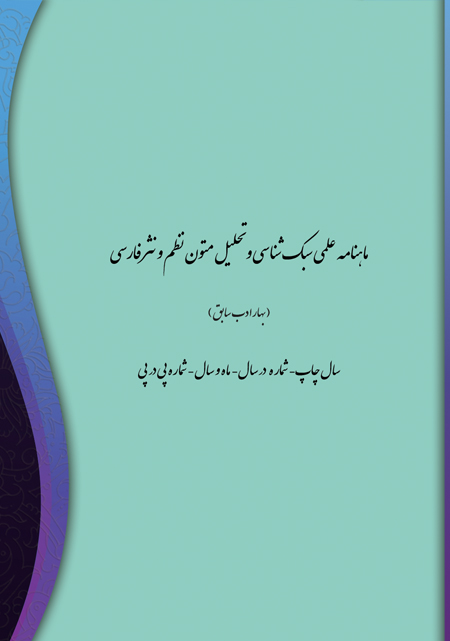- Count View : 12
- آدرس کوتاه شده مقاله: https://bahareadab.com/article_id/1877
- کد doi مقاله: Doi: 10.22034/bahareadab.2025 .18 .7886
Journal of the stylistic of Persian poem and prose
volume Number 18،
number In Volume 6،
،
issue Number 112
Study of the Four Central Personalities in Khamseh Nizami Based on the Enneagram Model
Samira Sohrabi , Mohammad Amir Obidinia (Author in Charge)
Abstract
BACKGROUND AND OBJECTIVES: The Enneagram is one of the notable and important models in modern psychological criticism, which is able to analyze and examine the personality dimensions of individuals with the help of nine personality types. The main objective of this article is to study and analyze the four central personalities in Nizami’s poetry based on the Enneagram model.
METHODOLOGY: In this study, using a descriptive-analytical method, we will study the four personalities of Khosrow, Majnun, Bahram Goor, and Iskander in Khamseh Nizami with respect to the personality types of the Enneagram.
FINDINGS: The research findings indicate that among the fictional characters of Khamseh Nizami, the types considered in the Enneagram theory can be adapted. The heroes of the military five reflect different spiritual characteristics and characteristics. With the help of this theory, the inner and complex layers of the four important and prominent personalities of the military five, including Khosrow, Majnun, Bahram Gour, and Iskander, were analyzed and explained.
CONCLUSION: The results of the research show that Khosrow"s personality is in the seventh type, Majnun"s personality is in the sixth type, Bahram Gour"s personality is in the third type, and Iskander"s personality is in the first type. The dominant aspect of Khosrow"s personality is fun-loving, Majnun is loyal, Bahram Gour is self-sufficient and resourceful, and Iskander is shown as a reformer.
Keyword
Military. Enneagram. Psychological criticism. Personality ty
- Ehsani Astahbanani. Mohammad Amin (2019). “Sociological Criticism of Key Characters of Khosrow and Shirin Nezami Ganjavi”. Scientific-Specialized Quarterly Journal of Language and Literature Studies. Year 9. Issue 33. pp. 24-9.
- Afzali Harsini. Behnaz et al. (2014). “Analysis of Characters in Balqis Soleimani’s Novels Based on the Enneagram Theory (Based on Balqis Soleimani’s Novels of the 1980s)”. Journal of Fiction Literature. Volume 13. Issue 3. pp. 31-64.
- Iravani. Mahmoud and Khodapanahi. Mohammad Karim (2017). Psychology of Emotion and Perception. Tehran: Samat, p. 23.
- Palmer. Helen (2019). Anagram: Personality in the Workplace and Life. Translated by Ehsan Alvandi. Tehran: Rasa, pp. 32-33-45-51.
- Tavakoli Ojani. Negar et al. (2010). “A review of the narrative of Alexander’s personality in Persian poetry and prose texts from the third to the sixth century AH”. Specialized monthly journal of Persian poetry and prose stylistics (Bahar Adab). Year 13. Issue 5. Consecutive 51. pp. 305-328.
- Khamr zaboli. Arefe et al. (2010). “Investigating the three levels of mental health in the characters of the novel Saq al-Bamboo based on the Enneagram theory”. Two quarterly scientific journals of contemporary Arabic literary criticism. Year 10. Issue 21 (consecutive). pp. 107-137.
- Daniels. David and Price. Virginia (2014). Personality (Enneagram). Translation: Nima Seyed Mohammadi. Third edition. Tehran: Arasbaran, pp. 67-79.
- Dasht-e-Arjaneh. Mahmoud Reza (2011). Psychological analysis of When Nietzsche Cried by Erwin William. Tehran: Contemporary Literature Research.
- Daghiqian. Parvin (2013). Psychology of the Nine Personality Types of the Enneagram. Third edition. Tehran: Ashianeh Ketab, pp. 43-50.
- Dehkhoda. Ali Akbar (1993). Dictionary. Second edition. Tehran: Tehran University Press.
- Dehghan. Ali et al. (1999). “Analysis of the Behavior of the Fictional Characters in the Poems of Khosrow and Shirin Nezami Based on the Theory of Moral Development of Kalbarak”. Scientific Journal of Scientific Literature Research. Year 13, Issue 50. pp. 59-88.
- Rezaei. Bita et al. (2017). “Psychological Analysis of the Personality Type of the King in the Story of the King and the Concubine of the Masnavi Based on the Enneagram Model”. Literary Textual Studies. Year 21. Issue 71. pp. 169-192.
- Risso, Don Richard and Hudson, Ross (2012). The Enneagram: A Window Beyond Personality. Translated by: Vajihehullah Golnavaz and Masoud Hassan Chari. Tehran: Ketab Arjomand, pp. 145-78-56.
- Sarreshtedari, Mehdi (2016). The Enneagram: The Nine Types of Personality. With an Introduction by: Mohammad Haqi. Fourth Edition. Tehran: Mehrandish, p. 3
- Sanatgar, Nozar (2013). The Persian Enneagram. Tehran: Ravian, pp. 143-57.
- Alizadeh, Maryam and others (2014). “A Study of the Characters in the Story Around the Shoka Cafe Based on Types Three and Four of the Enneagram Theory”. Scientific Journal of Stylistics and Analysis of Persian Poetry and Prose Texts (Former Bahar Adab). Year 17. Issue 12. Consecutive 106. pp. 76-61.
- Nizami. Elias bin Yusuf (1983). Generalities of Nizami Ganjavi's Five Books. With corrections and introduction by Moin-Far. Second edition. Tehran: Zarrin.
- Nowruz. Zeinab and others (1391). "A Study of Bahram's Personality in Haft Peykar with Attention to Maslow's Theory". Textual Studies of Persian Literature. Year 4. Issue 16. pp. 32-17.

